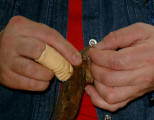|
Apart from
the really tiny ones, most teddy bears are
stitched
up by machine. I do assume that you
do the same, unless you do not have access to a sewing machine. If you
have never worked with one before, it’s easier to learn it than to sew
the whole bear by hand. By making bears, my children learned how to work
with a sewing machine. It won’t improve the quality if a bear is sewn
by hand, and it is very time consuming, as the stitches have to be very
short to withstand the stress
of stuffing. Even a machine-sewn bear still requires a lot of hand stitching
in the making. On the other side, sewing by hand is a very leisurely kind
of work, which you can do while watching TV or looking after your children.
|
 |
While sewing by hand most bearmakers get problems
with little holes in their finger tips , so sometimes
you may tell a bearmaker by horny spots.
Thimbles can help to avoid hurting the fingers, but only few
bearmakers are able to use them. So self made leather thimbles can be
helpful. |